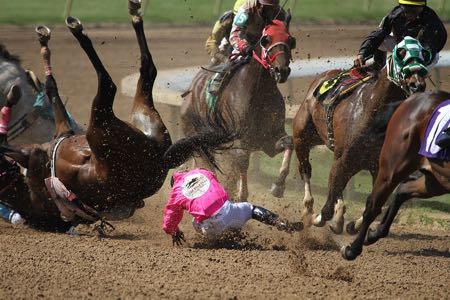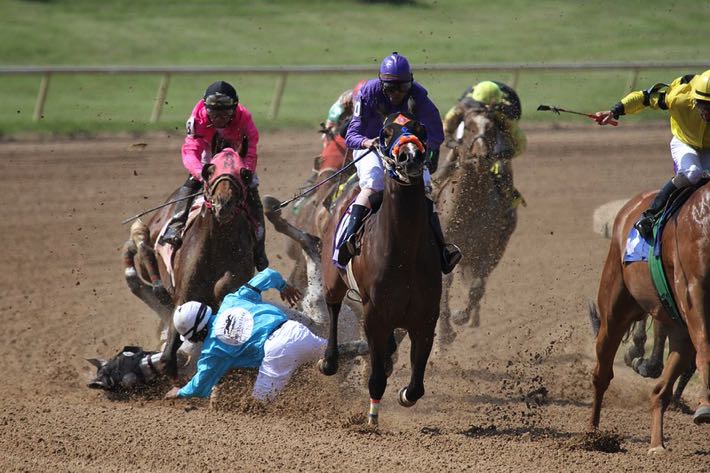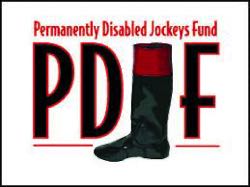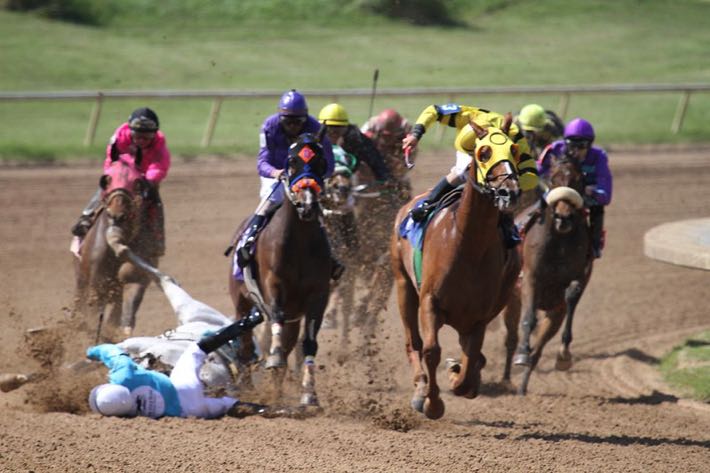
Horse racing is a dangerous profession, even it might not seem like it’s as dangerous as some other, more physical sports. Certainly, in terms of deaths, it isn’t as common an occurrence as some might think. When it comes to injuries, however, that is a different story, with most jockeys suggesting that they have spent the majority of their career carrying one form of injury or another. It is a common occurrence for jockeys to get injured, meaning that many are carrying an injury when taking part in the majority of races.
This is especially true for jump jockeys, who not only endure an increased risk of coming off the horse as they just a fence or land on the other side but who can also be landed on by horses behind them in the race. Interestingly, a study that looked at injuries sustained by British jockeys discovered that 30% of them occurred either before or after a race, suggesting that the racing alone isn’t the only dangerous part of a jockey’s day. For flat racing jockeys, injuries picked up in the starting gate are amongst the most common.
Jockey Deaths

Thankfully, the reality of horse racing is such that jockeys dying is a relatively rare occurrence. Indeed, when Lorna Brooke died after a fall at Taunton Racecourse in April of 2021, it was the first fatality on a British racecourse as a result of a fall since July 2005. Tom Halliday lost his life after a fall at Market Rasen, with the next death before that being Richard Davis at Southwell in 1996. In the case of Brooke, she was not an inexperienced jockey, having ridden in more than 400 races, mostly for her mother, whose horse she had been riding when she fell.
Brooke was riding Orchestrated for the owner-trainer, Lady Susan Brooke, when she took a heavy fall at the third fence. She was treated on track, with racing being delayed for more than an hour as she was transferred to an air ambulance. She was treated at hospital for a spinal injury, but had to be placed into an induced coma when there were complications. She failed to recover from the coma, eventually passing away as a result of the injuries that she sustained when she fell from the horse. The tragedy of her passing highlighting how rarely it actually happens.
Jockeys Dying as a Result of Racing Rare
In the United States of America, jockeys dying as a result of racing is equally as rare. A study looked at thoroughbred and quarter horse racing between 2007 and 2011, discovering that there was only one death during the period investigated. In the world of thoroughbred racing, 360 jockeys fell across 180,646 rides, whilst in quarter horse racing the numbers were 145 falls from 46,106 races. One death out of 226,752 race rides is obviously mercifully low, suggesting that the chance of death is low in horse racing in both the US and the United Kingdom.
Far More Dangerous for Horses
According to the study in the United States, a licensed jockey can expect to endure a fall every 502 rides if they ride in thoroughbred races and every 318 rides in the world of quarter horse races. The injury rates were similar across different racing jurisdictions, with deaths equally as low. It is certainly far to say that things are far more dangerous for the horses than the jockeys, with 493 Thoroughbred racehorses dying in the United States during 2018. If a horse breaks a leg the likelihood is that they will be put the sleep, but the same is not true of jockeys.
Only One Jockey Death at the Grand National
As a sign of how rare jockey deaths are, we need only look the Grand National. The ‘World’s Greatest Steeplechase’ is seen as one of the most challenging horse races on the planet, with fields regularly being whittled down on account of the fact that so many horses have fallen before the final fence comes into view. Even so, only one jockey has died during the race since it was first officially run in 1839. That was Joseph Wynne, who fell from his horse at the Chair. As he lay unconscious on the ground, a horse fell on top of him, crushing his sternum.
Injuries Are Common Place
 Whilst deaths of jockeys are mercifully low, the same cannot be said of injuries. Here’s a list of common injuries suffered by jockeys:
Whilst deaths of jockeys are mercifully low, the same cannot be said of injuries. Here’s a list of common injuries suffered by jockeys:
- Concussions
- Teeth kicked out
- broken collar bone
- Broken arm
- Broken wrist
- Broken thumb
- Numerous stitches
- Broken cheekbone
- Broken should blade
- Punctured lung
- Broken Ribs
- Broken vertebrae
- Broken leg
- Broken ankle
Whilst that list might seem excessive, it is, in fact, merely the list of injuries suffered by one jockey during their career. A.P. McCoy retired from horse racing as one of the most successful jockeys of all time, but he did so having suffered through the above list of injuries thanks to his horse racing exploits. When asked if he would suffer from the injuries later in his life, McCoy replied that he probably would but that he wouldn’t ‘change any of it for the world’. He also pointed to the idea that he was ‘mentally fitter and stronger’ than others in his profession.
McCoy is, of course, the rule rather than the exception. Given the fact that horses will often run at speeds in excess of 40mph, it is hardly surprising that jockeys pick up injuries during their rides. In the United States of America, for example, dozens of jockeys have to be helped by the Permanently Disabled Jockey Fund after picking up grave injuries when racing. In 2013, for example, one of the country’s top jockey’s, Ramon Dominguez, was thrown from his horse and kicked at New York’s Aqueduct Race Track, resulting in him being forced to retire.
A Breakdown of Injuries

In 2002, the British Journal of Sports Medicine, published a review of injuries suffered by jockeys in Great Britain and the Republic of Ireland between 1992 and 2000. The work broken racing down into its two main constituent parts of jump racing and flat racing, though an acknowledgement was made of the likes of point-to-point events. As an example of numbers, the study looked at the year 2000, during which, in Great Britain, there were 107 flat racing jockeys and 90 jump racers that had full registration, alongside 128 apprentices in each discipline.
There were also 462 amateur jockeys in flat racing, compared to 668 in jump racing. At the same time in Ireland, there were 59 flat racing jockeys and 133 jump jockeys. They were entering races alongside 85 apprentice jockeys in flat racing. In Britain, racing took place on 59 courses, with each course being responsible for an average of 20 meetings every year. In Ireland, racing was conducted on 27 courses, with each course boasting an average of 10 meetings per year. 2000 saw 1050 meetings help in Britain and 270 in Ireland.
The study goes into detail about the average weight of horses, how tall the obstacles tend to be in jump racing and so on. Obviously we’re not all that interested in such in-depth information, but it’s just to give you a sense of how well-informed the piece was. It was discovered that about 30% of injuries happened in the paddock, in the stalls or after the race had finished, with the jockeys at risk from the moment they come into contact with the horse that they are going to be riding during that day’s race, to say nothing of being liable to pick up injuries because of their riding positions.
Here is a look at the most common injuries suffered by jockeys in each of the disciplines, broken down by year:
| Year | Discipline | Injury Type | Number of Occurrences |
|---|---|---|---|
| 1992 | Flat Racing | Fracture | 9 |
| 1992 | Flat Racing | Dislocation | 0 |
| 1992 | Flat Racing | Concussion | 3 |
| 1992 | Flat Racing | Soft Tissue | 36 |
| 1992 | Jump Racing | Fracture | 98 |
| 1992 | Jump Racing | Dislocation | 10 |
| 1992 | Jump Racing | Concussion | 57 |
| 1992 | Jump Racing | Soft Tissue | 289 |
| 1993 | Flat Racing | Fracture | 7 |
| 1993 | Flat Racing | Dislocation | 0 |
| 1993 | Flat Racing | Concussion | 6 |
| 1993 | Flat Racing | Soft Tissue | 31 |
| 1993 | Jump Racing | Fracture | 89 |
| 1993 | Jump Racing | Dislocation | 10 |
| 1993 | Jump Racing | Concussion | 62 |
| 1993 | Jump Racing | Soft Tissue | 299 |
| 1994 | Flat Racing | Fracture | 12 |
| 1994 | Flat Racing | Disclocation | 0 |
| 1994 | Flat Racing | Concussion | 8 |
| 1994 | Flat Racing | Soft Tissue | 58 |
| 1994 | Jump Racing | Fracture | 87 |
| 1994 | Jump Racing | Dislocation | 5 |
| 1994 | Jump Racing | Concussion | 53 |
| 1994 | Jump Racing | Soft Tissue | 251 |
| 1995 | Flat Racing | Fracture | 4 |
| 1995 | Flat Racing | Dislocation | 0 |
| 1995 | Flat Racing | Concussion | 4 |
| 1995 | Flat Racing | Soft Tissue | 51 |
| 1995 | Jump Racing | Fracture | 59 |
| 1995 | Jump Racing | Dislocation | 6 |
| 1995 | Jump Racing | Concussion | 64 |
| 1995 | Jump Racing | Soft Tissue | 248 |
| 1996 | Flat Racing | Fracture | 11 |
| 1996 | Flat Racing | Dislocation | 2 |
| 1996 | Flat Racing | Concussion | 11 |
| 1996 | Flat Racing | Soft Tissue | 53 |
| 1996 | Jump Racing | Fracture | 75 |
| 1996 | Jump Racing | Dislocation | 10 |
| 1996 | Jump Racing | Concussion | 67 |
| 1996 | Jump Racing | Soft Tissue | 313 |
| 1997 | Flat Racing | Fracture | 7 |
| 1997 | Flat Racing | Dislocation | 0 |
| 1997 | Flat Racing | Concussion | 4 |
| 1997 | Flat Racing | Soft Tissue | 68 |
| 1997 | Jump Racing | Fracture | 72 |
| 1997 | Jump Racing | Dislocation | 9 |
| 1997 | Jump Racing | Concussion | 44 |
| 1997 | Jump Racing | Soft Tissue | 310 |
| 1998 | Flat Racing | Fracture | 8 |
| 1998 | Flat Racing | Dislocation | 0 |
| 1998 | Flat Racing | Concussion | 9 |
| 1998 | Flat Racing | Soft Tissue | 43 |
| 1998 | Jump Racing | Fracture | 72 |
| 1998 | Jump Racing | Dislocation | 6 |
| 1998 | Jump Racing | Concussion | 38 |
| 1998 | Jump Racing | Soft Tissue | 309 |
| 1999 | Flat Racing | Fracture | 8 |
| 1999 | Flat Racing | Dislocation | 0 |
| 1999 | Flat Racing | Concussion | 5 |
| 1999 | Flat Racing | Soft Tissue | 80 |
| 1999 | Jump Racing | Fracture | 65 |
| 1999 | Jump Racing | Dislocation | 8 |
| 1999 | Jump Racing | Concussion | 45 |
| 1999 | Jump Racing | Soft Tissue | 338 |
| 2000 | Flat Racing | Fracture | 7 |
| 2000 | Flat Racing | Dislocation | 0 |
| 2000 | Flat Racing | Concussion | 6 |
| 2000 | Flat Racing | Soft Tissue | 48 |
| 2000 | Jump Racing | Fracture | 62 |
| 2000 | Jump Racing | Dislocation | 7 |
| 2000 | Jump Racing | Concussion | 34 |
| 2000 | Jump Racing | Soft Tissue | 338 |
| Total | Flat Racing | Fracture | 64 |
| Total | Flat Racing | Dislocation | 2 |
| Total | Flat Racing | Concussion | 56 |
| Total | Flat Racing | Soft Tissue | 468 |
| Total | Jump Racing | Fracture | 614 |
| Total | Jump Racing | Dislocation | 62 |
| Total | Jump Racing | Concussion | 419 |
| Total | Jump Racing | Soft Tissue | 2,433 |
It is clear to see that jump racing is by far the more dangerous discipline in horse racing. The total number of soft tissue injuries suffered by flat racing jockeys between 1992 and 2000 is lower than the same injury type suffered by jump racing jockeys in 1992 and 1993 alone. Equally, two dislocations were suffered by flat racing jockeys in 1996 and no other dislocations occurred during the time period we’re looking at, whilst jump racing jockeys suffered at least double that number of dislocations every year in question.